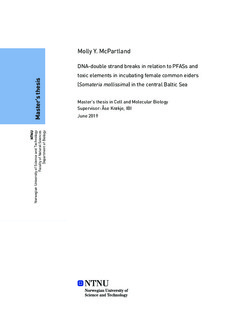| dc.description.abstract | Per- and polyfluorinated alkylated substances (PFASs) and toxic elements have both been linked to adverse effects on genetic material which can result in severe consequences for individuals and entire populations. The aim of study was to assess the impact of blood concentrations of PFASs and toxic elements on DNA double strand breaks (DNA-DSBs) in the Common Eider (Somateria mollissima) breeding on Christiansø, Denmark in 2018. Furthermore, blood clinical chemistry parameters (BCCPs) were used to analyze the overall health of the incubating Eiders. The colony assessed in this study is of interest as it has experienced two mass mortality events, is part of a declining population, and has been shown poor genetic health.
Using a non-invasive approach, the same incubating female Eiders were caught and sampled once on day 5 (n=25) and once on day 20 (n=23) of incubation to provide a biological baseline for each bird enabling comparison between the early and late stages of incubation. Blood cells from whole blood were used to analyze DNA-DSBs by agaroses gel electrophoresis where the migrated fraction of total DNA (DNA-FTM) and median molecular length (MML) was quantified. Blood concentrations of chemical elements and PFASs were quantified using high resolution inductively coupled plasma mass spectrometry (HR-ICP-MS) and liquid chromatography tandem-mass spectrometry (LC−MS/MS), respectively. BCCPs were provided by Aarhus University as part of a routine procedure associated with a larger research project concerning Eiders on Christiansø, Denmark.
PFASs, Cadmium (Cd), and Lead (Pb) blood concentrations increased from day 5 to day 20 of incubation most likely due to reuptake caused by lipid and protein metabolism during fasting. Zinc (Zn), Calcium (Ca), Potassium (K), Iron (Fe), Selenium (Se) and many BCCPs decreased, again likely due to fasting causing depletion of essential elements and metabolic enzymes. Strong positive correlations between body mass, total protein and albumin support the likelihood that protein catabolism is occurring meaning the Eiders have entered the third stage of fasting.
Blood concentrations of Pb were significantly elevated and well above toxicity threshold levels at which adverse effects and mortality can occur. The Pb blood levels in 2017 were significantly lower than in 2018 indicating a new point source pollution. It is possible the Christiansø Eider colony is experiencing Pb poisoning and in danger of another mass mortality event.
On day 5 of incubation DNA-DSBs were negatively correlated to PFASs while on day 20 DNA-DSBs were negatively correlated to PFASs and Mercury (Hg), but positively correlated to body mass. This indicates that as the stress of incubation increases, represented by decreases in body mass, DNA integrity decreases in tandem. However, unexpectedly, as blood concentrations of Hg and PFASs increase, DNA integrity increases in tandem. This can possibly be explained by nonlinear dose-response relationships, adaptive responses to chronic exposure, or increased rates of apoptosis and decreased rates of DNA repair.
The results of this study show the importance of continuing to monitor the Christiansø Eider colony and are applicable for both the conservation of the Christiansø Eider colony and for elucidating the complex mechanisms behind maintaining genetic homeostasis despite stress from multiple sources. | |
